
Do your samples need extreme precision, or just a quick stir? Here’s how to choose the right features for the output you need.
When buying a lab stirrer or shaker, there are a few things to consider to make sure the product you choose offers the precision, control, and reliability your application needs.
We’ve created a guide to walk you through your decision making, outlining some application
differences between stirrers and shakers, highlighting key features of the equipment, as well as giving you a brief overview of price ranges.
Stirrers vs. Shakers
In a nutshell, laboratory stirrers and shakers create a homogenous mixture from multiple ingredients.
Think of James Bond’s infamous Vesper Martini. Shaken, not stirred. You have the gist of the two mixing methods.
- Stirrers use a tool, such as a paddle or a blade or a magnet, that mechanically stirs the sample.
- Shakers shake the mixtures placed on their plates to create turbulence and mix the substance.
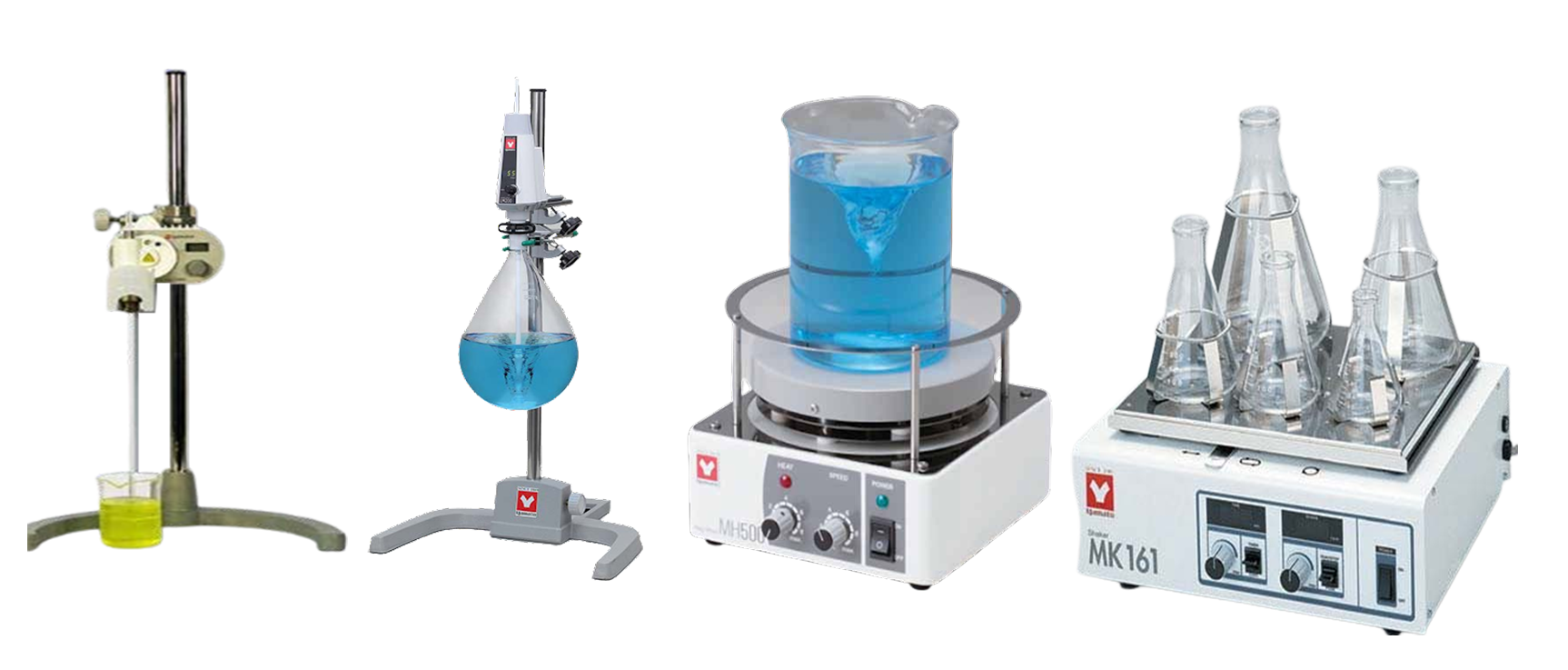
KEY FEATURES
Adjustable Rotation Speed (RPM)
Shaker and stirrer rotation speed is measured in RPMs (revolutions-per-minute).
When you set your rotation speed, you expect that to stay consistent, despite viscosity changes that often happen during mixing applications.
One way to verify your speed is with digitally displayed speed-based configurations. This helps figure out if the stirrer or shaker retains its set speed despite viscosity changes throughout the process to track and deliver reliable and accurate results. Obviously, this is more important in hush precision applications, where your end result is highly dependent on specific turbulence in the mixture.
When that kind of precision isn’t required, a manual control is sufficient, and doesn’t eat into your lab’s budget as significantly.
Yamato LM Series, LT Series, LR Series and MK Series are designed with digitally-displayed speed setting while MH and MG Series, MB800 and SA Series come with dial settings.
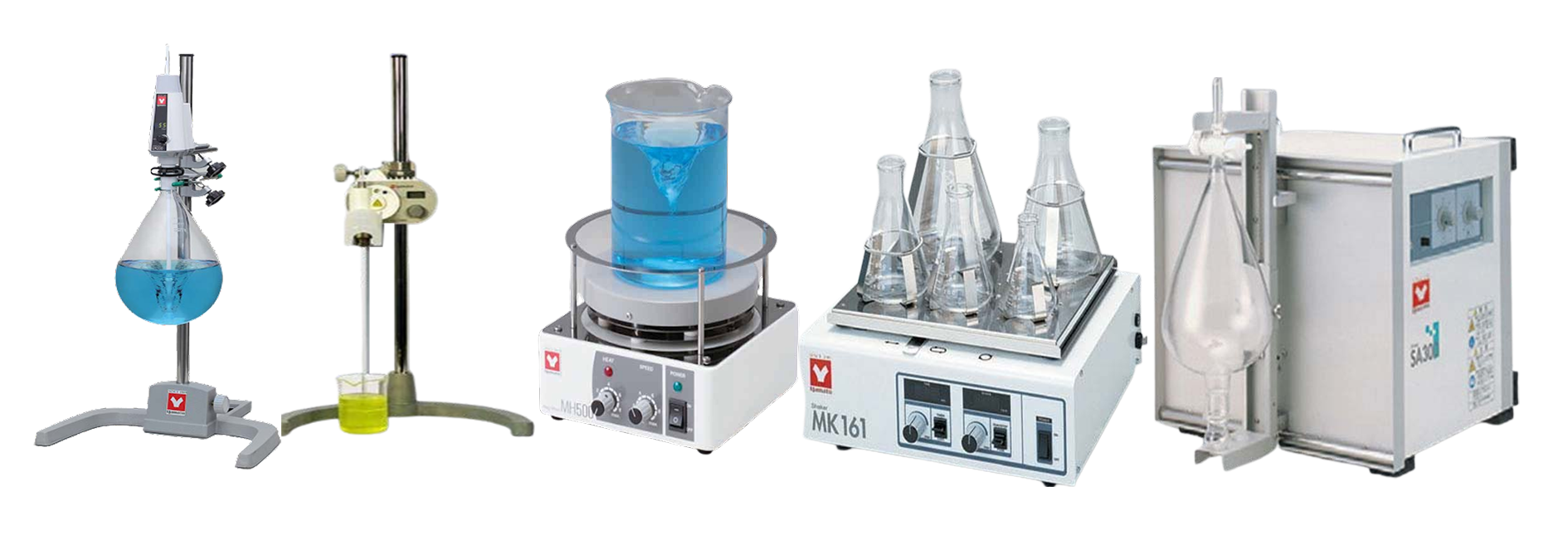
Download the Complete Buyer’s Guide to Stirrers and Shakers here
Motor
Most stirrers and shakers come equipped with direct current (DC) motors. It’s what you’re used to in your lab. DC motors are the engine of choice because they offer vast speed variation as well as highly controllable speed. While many DC motors use brushes and rubberized belts, some models provide brushless motors to reduce maintenance costs so you can spend more time on science and less time on logistics.
- Brushed motors are made of carbon and decline over time due to friction.
- Brushless units use magnets to generate power. That means there’s no friction, they produce very little heat, and perform better across the entire lifetime of the product
With brushless, you pay a little more initially, but you won’t need to worry about extra maintenance costs. Yamato LM, LT and LR Series are equipped with DC brushless motors. The actual speed of the motor is measured in horsepower. A stirrer or shaker with more horsepower can mix a larger, more viscous sample, but it also takes up more benchtop space. To make the best use of limited space in your lab, avoid bringing in more horsepower than you need. When choosing the type of motor on a stirrer or shaker, think about the viscosity and size of the samples you usually work with.
Torque
In simple terms, torque is the engine’s rotational force. It differs from horsepower, as it refers to the amount of work an engine can exert, while horsepower defines how quickly the work is completed. If the torque doesn’t work well with the sample being mixed, a stirrer might
be unable to turn its impeller, halting the mixing process, straining the motor, and potentially damaging the impeller itself.
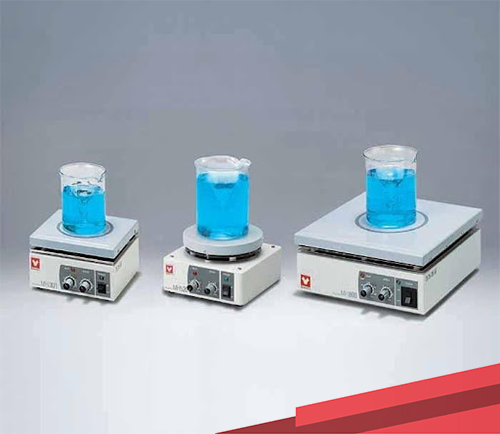
Depending on the amount of torque and the diameter of the impellers, the stirrer can support impeller rotation in higher viscosity mixtures. Even a tiny increase in an impeller diameter and speed will cause a massive increase in the power required for mixing.
Programmability
Being able to automate any process can free up an operator’s time to work on other tasks. To allow this, many modern stirrers and shaker systems can be programmed ahead of time to complete specific stirring and shaking commands, depending on the needs of the samples and process. Automation also reduces the chances of user error to make sure that tasks get completed accurately.
So what can be programmed? Some units feature some or all of the following:
- Display units for torque and speed.
- Torque limits (including zero torque).
- Timers.
- Shutdown time.
- Data logging parameters. Stirring direction and intervals.
Adjustable Temperature
Based on the sample(s) under consideration, temperature control can be an important feature in your instrument. For samples requiring heat during mixing, choose a stirrer with a hot plate that can reach the boiling point of the sample. An example would be Yamato’s MH and MG Series with hot plates made of chemical-resistant, heat conductive aluminum with ceramic coating.
Alternatively, you can also immerse the vessel in a water bath for samples being mixed using an overhead stirrer if the maximum required temperature is moderate. A stirrer with a temperature sensor built-in allows operators to monitor the temperature of their samples in real-time.
Safety
Stirrer controls should be simple and intuitive, especially when multiple users share the same workspace. Stirrers with analog controls are potentially more familiar to new graduates (as they probably used these instruments coming up through school), and digital displays are more familiar to experienced users. They’re also more precise.
Additionally, to prevent spilling and sloshing, match your labware with the mixing or shaking speed and pitch of your stirrer or shaker. Stirring or shaking that becomes too strong can cause liquids to spill from low-profile or poorly-covered containers. These spills can create messes on the stirrer or shaker’s surface or the benchtop. Fluid can even leak into the motor, damaging the stirrer or shaker.
Luckily, some stirrer and shaker models come with stop and start automation to prevent spilling and sloshing, as well as safety circuits for automatic cutoff to prevent the sample and the unit from damage during overly vigorous mixing.
High-end models even come with a remote so users can pause or stop the process from a safe distance if the mixture begins spilling or sloshing.
Optional Accessories
No lab is the same. Accessories allow the user to personalize their equipment to fit their unique applications and to accommodate new sample types and processes. To optimize the performance of your equipment, check if a stirrer or shaker lets you add on accessories. Many stirrers and shakers are designed to accommodate:
- Tube racks
- Paddles
- Clamps
- Stands
- Platforms
Types of Stirrers
Overhead Lab Stirrers
An overhead lab stirrer can be used for:
- Mixing
- Homogenizing
- Suspending
- Recirculating
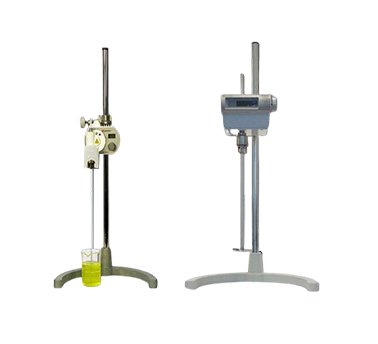
…large volumes or high-viscosity substances. They often feature useful safety features, like sensors that shut down the motor if it overheats (which can happen with highly viscous liquids).
When buying an overhead stirrer for general lab use, compare it against the largest volume and thickest viscosity it would be used to mix, as they come in a variety of sizes and speeds. Viscosity is measured in centipoise (cP or cps) or millipascal seconds (mPa·s). If you don’t know the exact viscosity you work with, you can get an estimate from any of the free viscosity tables available online.
LM, LT and LR Series are Yamato’s models of overhead lab stirrers.
Magnetic Lab Stirrers
A magnetic stirrer consists of a magnetic bar or series of electromagnets placed within the liquid. The magnets create a rotating magnetic field within the liquid. The bar spins, mixes, and creates turbulence in the mixture.
Compared to gear-driven stirrers, magnetic stirrers are:
- Quieter
- More efficient
- Free of degrading, moving parts
Generally, magnetic stirrers are used for small experiments, typically with 4 liters of liquid or less.
Magnetic lab stirrers are available with a heated platform or a non-heated platform and should only be used with glass or other non-metal beakers to prevent interference with the magnetic field.
Heated magnetic lab stirrers
are a combination of a hot plate and a stirrer. The easily accessible adjustment knobs allow the operator to control both the platform temperature as well as the mixing speed. These come in single- position or multi-position platform units.
- Multi-position heated magnetic lab stirrers will mix and heat multiple flasks at a time in multiple positions on the platform.
- Single position heated magnetic lab stirrers will mix and heat one flask at a time in only one position on the platform.
Yamato MH and MG Series are examples of heated magnetic lab stirrers.
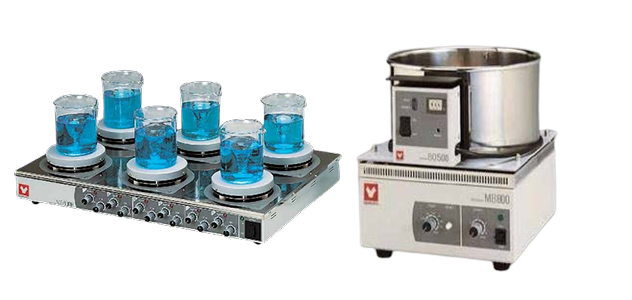
Non-heated magnetic lab stirrers,
unsurprisingly, don’t use heat. The rotation speed of the spin bar is adjustable and comes in single-position or multi-position platform units. If the samples you need to mix don’t require heat, there’s no reason to invest in an instrument with that feature. Non-heated units are more affordable.
Multi-position non-heated magnetic lab stirrers will mix multiple flasks at a time, in more than one position on the platform.
Single-position non-heated magnetic lab stirrers will mix one flask at a time, in only one position on the platform.
Yamato’s MB800 non-heated magnetic stirrer which is used with Yamato BO500 oil bath employs a magnetic stirrer bar to agitate solutions.
Types of Shakers
Reciprocal Shakers
Reciprocal shakers are used for mixing liquids gently or vigorously in a motion that pushes the mixture from back and forth within the flask. A few advantages of a reciprocal shaker:
- They are versatile
- They have a small footprint
Yamato’s compact shakers are MK161 and MK201D. MK161 is capable of changeable rotary, elliptical and reciprocate motions while MK201D is designed with changeable rotary and reciprocate shaking method. On the other hand, SA Series Laboratory Shaker can do horizontal, vertical and rotary shaking.

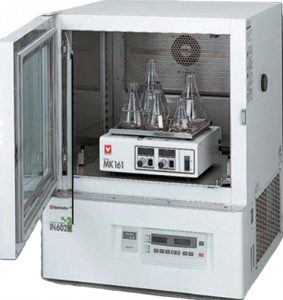
Incubating/Refrigerating Shakers
Incubating and/or refrigerating shakers are exactly what they sound like. They combine temperature control with the shaking functions that a classic shaker offers, making them ideal for operators where temperature has an impact on the final output.
Some of these shakers are programmable, allowing operators to incubate and/or refrigerate the samples within their shakers through automated processes. And, of course, this automated help comes with a greater price tag.
PRICE RANGES
Stirrers and shakers can be sold in the form of a “main body” (individual parts), or a set.
The more stirring points or flask space a stirrer or shaker has, the higher the price goes. Though many models provide stirring/shaking action in only one direction (left to right), some models offer multi-directional movement (circular), also increasing the price. Varying from model to model, stirrers generally start around a few hundred dollars, and basic shaker models begin at about double the cost of basic stirrers. Both can run into the thousands.
Whether you’re on the market for a stirrer or a shaker, it’s clear that your options are vast. There are a lot of intricacies to consider before spending your budget on a new instrument – even something as simple as a stirrer or shaker.
Still need to do more research? Yamato Scientific America is here to help. Contact us at 1-800-292- 6286 or reach us at [email protected]
Download the Complete Buyer’s Guide to Stirrers and Shakers here